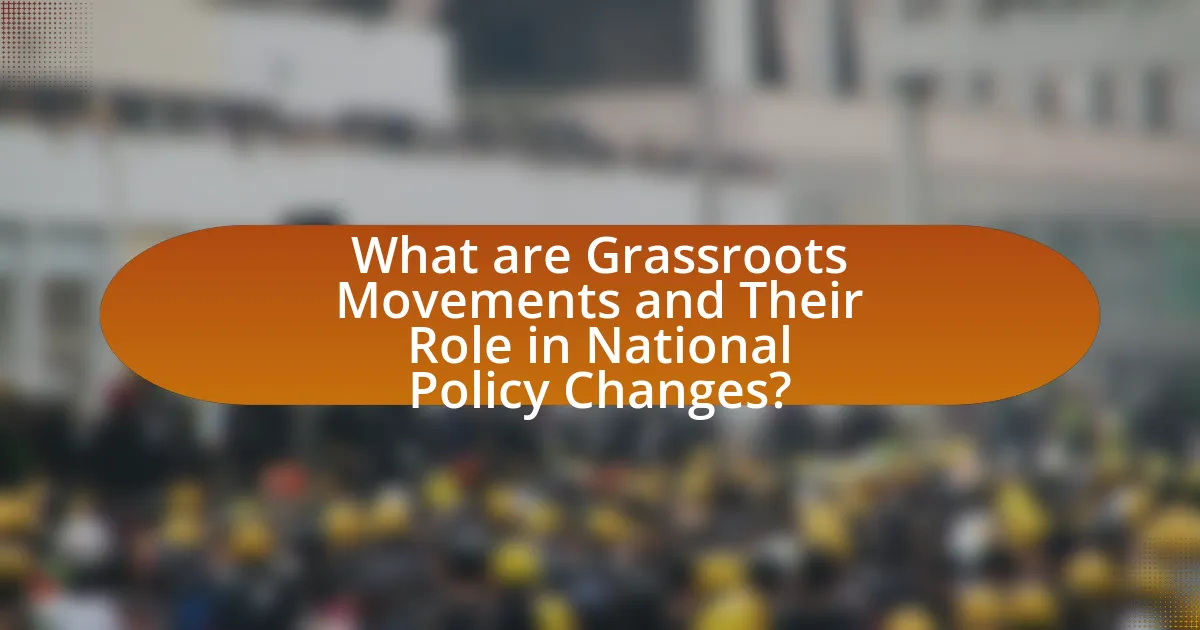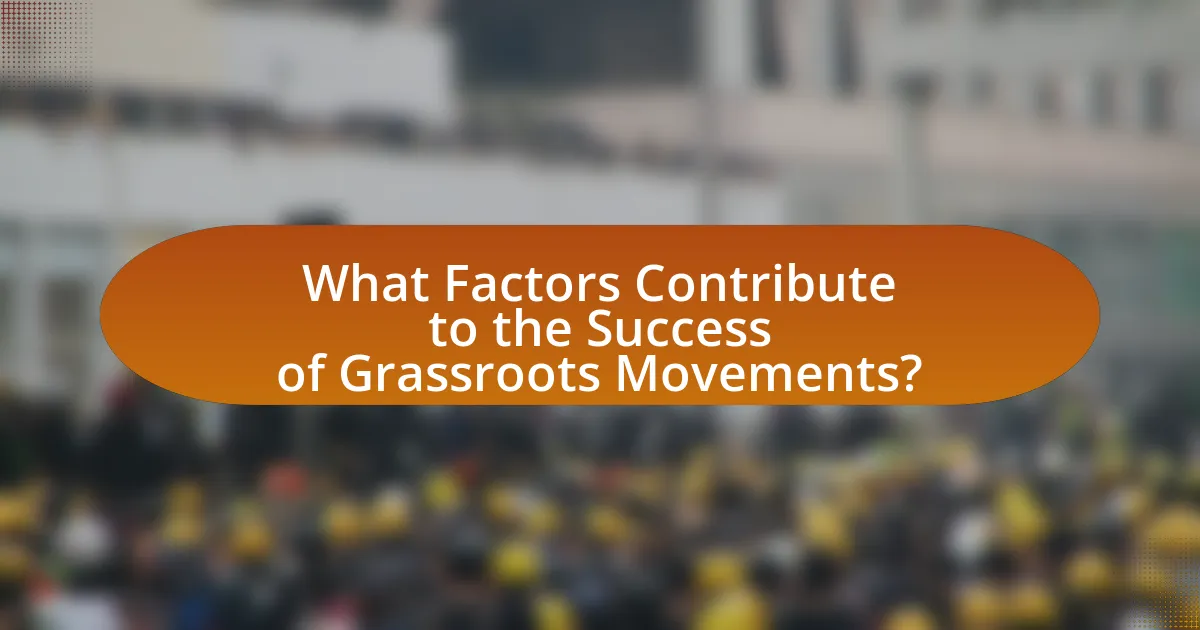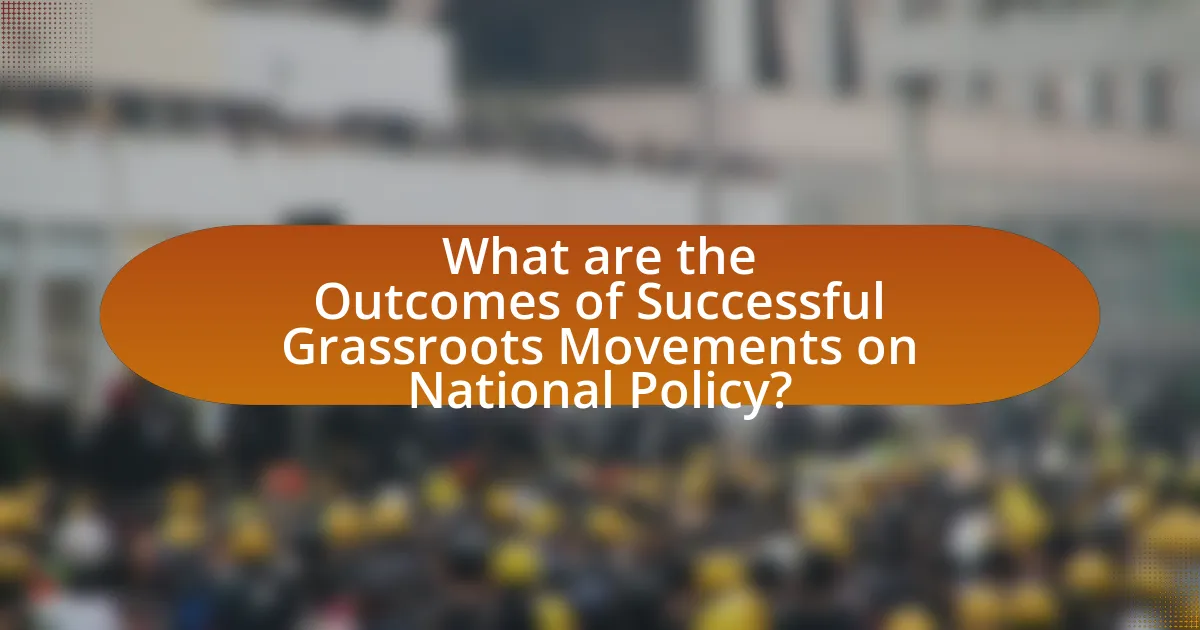Grassroots movements are organized efforts by ordinary individuals aimed at achieving social or political change, often starting at the local level and influencing national policy. This article examines the mechanisms through which grassroots movements initiate policy changes, including community mobilization, social media engagement, and coalition-building. It highlights historical examples such as the Civil Rights Movement and the Women’s Suffrage Movement, illustrating their significant impact on legislation. Additionally, the article discusses the challenges these movements face, strategies for overcoming obstacles, and the importance of public engagement in shaping public opinion and legislative agendas. Ultimately, it emphasizes the role of grassroots activism in driving meaningful policy reforms.

What are Grassroots Movements and Their Role in National Policy Changes?
Grassroots movements are organized efforts by ordinary people to effect social or political change, often at the local level, which can influence national policy changes. These movements mobilize community members to advocate for specific issues, such as civil rights, environmental protection, or healthcare reform, thereby raising awareness and applying pressure on policymakers. Historical examples include the Civil Rights Movement in the 1960s, which led to significant legislative changes like the Civil Rights Act of 1964, demonstrating how grassroots activism can directly impact national policy.
How do grassroots movements initiate change in national policies?
Grassroots movements initiate change in national policies by mobilizing community members to advocate for specific issues, thereby influencing public opinion and policymakers. These movements often utilize strategies such as organizing protests, leveraging social media for awareness, and building coalitions to amplify their message. For instance, the Civil Rights Movement in the United States effectively used grassroots organizing to challenge segregation laws, leading to significant legislative changes like the Civil Rights Act of 1964. This demonstrates that grassroots efforts can create substantial pressure on national leaders to enact policy reforms that reflect the demands of the populace.
What strategies do grassroots movements employ to influence policymakers?
Grassroots movements employ strategies such as mobilizing community engagement, leveraging social media, and forming coalitions to influence policymakers. Mobilizing community engagement involves organizing local events, rallies, and town hall meetings to raise awareness and demonstrate public support for specific issues, which can pressure policymakers to take action. Leveraging social media allows grassroots movements to disseminate information rapidly, engage a broader audience, and create viral campaigns that attract attention from both the public and policymakers. Forming coalitions with other organizations amplifies their voice and resources, increasing their influence on legislative agendas. For instance, the Women’s March in 2017 effectively utilized these strategies to advocate for women’s rights and social justice, resulting in significant political discourse and policy discussions.
How do grassroots movements mobilize community support?
Grassroots movements mobilize community support by fostering local engagement and building networks of individuals who share common goals. These movements often utilize strategies such as community organizing, social media campaigns, and public events to raise awareness and encourage participation. For instance, the Black Lives Matter movement effectively mobilized support through social media platforms, leading to widespread protests and policy discussions on racial justice. Research indicates that grassroots efforts can significantly influence public opinion and policy outcomes, as seen in the successful campaigns for climate action and healthcare reform, which gained traction through community-driven initiatives.
Why are grassroots movements significant in shaping public policy?
Grassroots movements are significant in shaping public policy because they mobilize community members to advocate for change, influencing decision-makers and public opinion. These movements often arise from local issues, allowing them to address specific needs and concerns that may be overlooked by traditional political processes. For instance, the Civil Rights Movement in the United States effectively utilized grassroots organizing to challenge systemic racism, leading to landmark legislation such as the Civil Rights Act of 1964. This demonstrates how grassroots efforts can create substantial shifts in policy by raising awareness, building coalitions, and applying pressure on policymakers to respond to the demands of the community.
What historical examples illustrate the impact of grassroots movements on policy?
Grassroots movements have significantly influenced policy changes throughout history, with notable examples including the Civil Rights Movement in the United States and the Women’s Suffrage Movement. The Civil Rights Movement, particularly from the 1950s to the 1960s, led to landmark legislation such as the Civil Rights Act of 1964 and the Voting Rights Act of 1965, which dismantled legal segregation and protected voting rights for African Americans. This movement was characterized by widespread protests, grassroots organizing, and advocacy, demonstrating the power of collective action in shaping national policy. Similarly, the Women’s Suffrage Movement culminated in the passage of the 19th Amendment in 1920, granting women the right to vote in the U.S. This achievement was the result of decades of grassroots campaigning, rallies, and lobbying efforts by activists who mobilized public support for gender equality in voting. These historical examples illustrate how grassroots movements can effectively drive significant policy changes by mobilizing communities and influencing public opinion.
How do grassroots movements differ from traditional advocacy groups?
Grassroots movements differ from traditional advocacy groups primarily in their structure and approach to mobilization. Grassroots movements are typically community-driven, relying on local individuals and volunteers to organize and advocate for change, often emerging spontaneously in response to specific issues. In contrast, traditional advocacy groups usually have formal organizational structures, established leadership, and funding sources, which guide their campaigns and strategies.
For example, the Civil Rights Movement in the 1960s exemplified a grassroots approach, where local activists mobilized communities to demand social justice, while organizations like the American Civil Liberties Union (ACLU) represent a traditional advocacy model with a structured framework and professional staff focused on legal advocacy. This distinction highlights how grassroots movements often prioritize direct community engagement and collective action, whereas traditional advocacy groups may emphasize policy analysis and lobbying efforts.

What Factors Contribute to the Success of Grassroots Movements?
The success of grassroots movements is primarily influenced by community engagement, effective communication, and strategic leadership. Community engagement fosters a sense of ownership and mobilizes individuals to participate actively, as seen in the Civil Rights Movement, where local involvement was crucial for achieving legislative changes. Effective communication, including the use of social media, allows movements to spread their message widely and rally support, exemplified by the Women’s March in 2017, which drew millions globally through coordinated online efforts. Strategic leadership ensures that movements remain focused and organized, as demonstrated by the leadership structures in the LGBTQ+ rights movement, which helped navigate complex political landscapes to achieve significant policy advancements. These factors collectively enhance the ability of grassroots movements to influence national policy changes.
How does public engagement affect the effectiveness of grassroots movements?
Public engagement significantly enhances the effectiveness of grassroots movements by increasing visibility, fostering community support, and amplifying collective voices. When individuals actively participate in grassroots initiatives, they contribute to a larger network that can mobilize resources, share information, and create a unified front. For instance, the 2017 Women’s March, which drew millions of participants globally, exemplified how public engagement can elevate issues like women’s rights and social justice to national attention, influencing policy discussions and legislative actions. Research indicates that movements with higher public engagement levels are more likely to achieve their goals, as demonstrated by the success of the Black Lives Matter movement in raising awareness and prompting policy reforms related to police practices.
What role does social media play in grassroots mobilization?
Social media serves as a crucial tool for grassroots mobilization by facilitating rapid communication and organization among supporters. It enables grassroots movements to disseminate information quickly, rally participants for events, and amplify their messages to a broader audience. For instance, during the Arab Spring, platforms like Twitter and Facebook were instrumental in organizing protests and sharing real-time updates, demonstrating how social media can mobilize large groups effectively. Additionally, studies show that social media engagement can significantly increase participation rates in grassroots campaigns, as seen in the 2018 March for Our Lives movement, which utilized social media to mobilize hundreds of thousands of participants across the United States.
How do grassroots movements build coalitions with other organizations?
Grassroots movements build coalitions with other organizations by identifying shared goals and values, which fosters collaboration. These movements often engage in outreach to like-minded organizations, facilitating discussions that highlight mutual interests and potential synergies. For example, the Civil Rights Movement in the 1960s successfully allied with labor unions and religious groups, amplifying their collective voice and resources. This strategic alignment not only strengthens advocacy efforts but also enhances visibility and influence in policy discussions, as evidenced by the passage of the Civil Rights Act of 1964, which resulted from such coalitions.
What challenges do grassroots movements face in influencing national policy?
Grassroots movements face significant challenges in influencing national policy, primarily due to limited resources, lack of access to decision-makers, and opposition from established interests. Limited financial and human resources hinder their ability to mobilize effectively and sustain campaigns. Additionally, grassroots organizations often struggle to gain direct access to policymakers, who may prioritize the interests of larger, more established groups. For instance, a study by the National Democratic Institute found that grassroots movements frequently encounter resistance from entrenched political structures that favor the status quo, making it difficult to enact change. Furthermore, the media landscape can be biased, often favoring mainstream narratives over grassroots perspectives, which diminishes their visibility and impact.
How do political opposition and institutional barriers impact grassroots efforts?
Political opposition and institutional barriers significantly hinder grassroots efforts by limiting access to resources, reducing visibility, and creating legal obstacles. For instance, political opposition can manifest through unfavorable legislation or lack of support from local governments, which can stifle the mobilization of community members and restrict funding opportunities. Institutional barriers, such as bureaucratic red tape or restrictive regulations, can impede grassroots organizations from effectively implementing their initiatives. A study by the National Democratic Institute found that grassroots movements facing strong political opposition often struggle to gain traction, as they are unable to secure necessary permits or funding, ultimately diminishing their impact on national policy changes.
What strategies can grassroots movements use to overcome these challenges?
Grassroots movements can overcome challenges by employing strategies such as building coalitions, leveraging social media, and engaging in community organizing. Building coalitions allows these movements to unite diverse groups, amplifying their voice and resources, as seen in the success of the Women’s March, which brought together various organizations to advocate for women’s rights. Leveraging social media enables grassroots movements to reach wider audiences quickly and mobilize supporters effectively; for instance, the #BlackLivesMatter movement utilized platforms like Twitter and Instagram to raise awareness and drive action. Engaging in community organizing fosters local support and empowers individuals to take action, exemplified by the community-led initiatives in the Fight for $15 campaign, which successfully advocated for higher minimum wages across multiple states. These strategies collectively enhance the effectiveness of grassroots movements in influencing national policy changes.

What are the Outcomes of Successful Grassroots Movements on National Policy?
Successful grassroots movements can lead to significant changes in national policy by mobilizing public support, influencing legislative agendas, and prompting government accountability. For instance, the Civil Rights Movement in the United States resulted in landmark legislation such as the Civil Rights Act of 1964 and the Voting Rights Act of 1965, which dismantled institutional racism and expanded voting rights. Additionally, the environmental movement has led to the establishment of policies like the Clean Air Act and the Clean Water Act, showcasing how grassroots advocacy can shape regulatory frameworks. These outcomes demonstrate that grassroots movements can effectively alter national policy landscapes through sustained activism and public engagement.
How do grassroots movements lead to tangible policy changes?
Grassroots movements lead to tangible policy changes by mobilizing community support and influencing public opinion, which pressures policymakers to act. For instance, the Civil Rights Movement in the 1960s utilized mass protests and grassroots organizing to highlight racial injustices, ultimately resulting in landmark legislation such as the Civil Rights Act of 1964. This demonstrates how sustained advocacy and collective action can create a political environment conducive to policy reform. Additionally, research shows that grassroots campaigns can effectively raise awareness and shift narratives, making it difficult for legislators to ignore the demands of their constituents, as seen in the recent climate action movements that have prompted legislative discussions on environmental policies.
What metrics can be used to measure the success of grassroots movements?
Metrics that can be used to measure the success of grassroots movements include the level of public engagement, policy changes influenced, and the growth of membership or support. Public engagement can be quantified through social media interactions, attendance at events, and participation in campaigns, indicating the movement’s reach and resonance with the community. Policy changes can be tracked by analyzing legislative outcomes that align with the movement’s goals, such as new laws or amendments resulting from advocacy efforts. Additionally, growth in membership or support can be assessed through membership numbers, donations, and volunteer involvement, reflecting the movement’s ability to mobilize and sustain interest over time. These metrics provide concrete evidence of a grassroots movement’s effectiveness in driving change and influencing national policy.
How do grassroots movements influence public opinion and legislative agendas?
Grassroots movements significantly influence public opinion and legislative agendas by mobilizing community engagement and raising awareness on specific issues. These movements often utilize social media, public demonstrations, and grassroots organizing to amplify their messages, which can shift public perceptions and create pressure on lawmakers. For instance, the Black Lives Matter movement has effectively changed public discourse around racial justice and police reform, leading to legislative proposals in various states aimed at addressing systemic racism. Research indicates that grassroots campaigns can lead to increased voter turnout and engagement, further impacting legislative priorities.
What lessons can be learned from successful grassroots movements?
Successful grassroots movements demonstrate the importance of community engagement and collective action in driving social change. These movements often mobilize individuals around a shared cause, illustrating that grassroots organizing can effectively influence national policy. For instance, the Civil Rights Movement in the United States, which utilized grassroots strategies to challenge systemic racism, led to significant legislative changes such as the Civil Rights Act of 1964. This highlights that sustained advocacy and public pressure can result in tangible policy outcomes. Additionally, successful grassroots movements often leverage social media to amplify their message, as seen in the Arab Spring, where digital platforms facilitated widespread mobilization and awareness. This underscores the necessity of adapting communication strategies to modern technologies for effective outreach and engagement.
What best practices should new grassroots movements consider for effective advocacy?
New grassroots movements should prioritize building a strong community network for effective advocacy. Establishing connections among supporters fosters collaboration and amplifies voices, which is crucial for mobilizing resources and influencing policy. Research indicates that movements with robust grassroots networks, such as the Civil Rights Movement, achieved significant legislative changes by leveraging community engagement and collective action. Additionally, utilizing social media platforms enhances outreach and facilitates real-time communication, allowing movements to adapt quickly to changing circumstances and maintain momentum.
How can grassroots movements sustain momentum after achieving policy changes?
Grassroots movements can sustain momentum after achieving policy changes by maintaining community engagement and leveraging their networks for ongoing advocacy. Continued communication with supporters through regular updates, events, and campaigns keeps the community invested in the movement’s goals. For instance, the Women’s March, which began as a response to the 2016 election, has successfully organized annual events to mobilize supporters and address ongoing issues, demonstrating the effectiveness of sustained engagement. Additionally, establishing partnerships with other organizations can amplify efforts and resources, as seen in the collaboration between environmental groups and social justice organizations to address climate change policies. These strategies ensure that grassroots movements remain relevant and influential in shaping future policies.
What practical steps can individuals take to support grassroots movements?
Individuals can support grassroots movements by actively participating in local initiatives, volunteering time, and donating resources. Engaging in community events, such as rallies or workshops, helps raise awareness and mobilize support for the cause. Volunteering skills, whether in organizing, outreach, or social media, directly contributes to the movement’s effectiveness. Financial contributions, even small amounts, can significantly enhance the capacity of grassroots organizations to implement their programs and campaigns. Research indicates that grassroots movements, such as the Civil Rights Movement, have historically influenced national policy changes by mobilizing community support and demonstrating public demand for reform.


